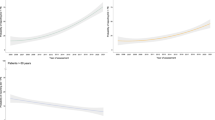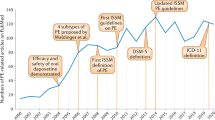Abstract
This study compared the prevalence of premature ejaculation (PE) diagnosed by the PE diagnostic tool (PEDT) score, self-reporting and stopwatch-recorded intravaginal ejaculation latency time (IELT). It examined the characteristics of males diagnosed with PE by each criterion. A questionnaire survey enrolled 2081 subjects from March to October, 2010. Stopwatch-recorded IELT was measured in 1035 of the 2081 subjects. We aimed to determine whether PE has an influence on the frequency and satisfaction of sexual intercourse, the degree of libido/erectile function and the satisfaction. These factors were evaluated according to different definitions of PE to assess whether the definition used yielded differences in the data. The prevalence of PE, based on a PEDT score of ⩾11, self-reporting and stopwatch-recorded IELT of ⩽1 min was 11.3%, 19.5% and 3%, respectively. The prevalence of PE diagnoses based on PEDT score and self-reporting increased with age, but stopwatch-recorded IELT-based diagnoses did not. Males experiencing PE showed lower levels of libido, erectile function and frequency and satisfaction of sexual intercourse compared with non-PE males. PE males felt that they did not satisfy their partners in terms of the partners’ sexual satisfaction and frequency of orgasm, in comparison with non-PE males. PE is a highly prevalent sexual dysfunction in males. Regardless of whether the PE diagnosis was made on the basis of self-reporting, PEDT score or stopwatch-recorded IELT, subjective symptoms were similar among PE males.
This is a preview of subscription content, access via your institution
Access options
Subscribe to this journal
Receive 8 print issues and online access
$259.00 per year
only $32.38 per issue
Buy this article
- Purchase on Springer Link
- Instant access to full article PDF
Prices may be subject to local taxes which are calculated during checkout

Similar content being viewed by others
References
Montague DK, Jarow J, Broderick GA, Dmochowski RR, Heaton JP, Lue TF et al. AUA guideline on the pharmacologic management of premature ejaculation. J Urol 2004; 172: 290.
Rosen RC . Prevalence and risk factors of sexual dysfunction in men and women. Curr Psychiatry Rep 2000; 2: 189.
Rowland D, Perelman M, Althof S, Barada J, McCullough A, Bull S et al. Self-reported premature ejaculation and aspects of sexual functioning and satisfaction. J Sex Med 2004; 1: 225.
Laumann EO, Nicolosi A, Glasser DB, Paik A, Gingell C, Moreira E et al. Sexual problems among women and men aged 40-80 y: prevalence and correlates identified in the Global Study of Sexual Attitudes and Behaviors. Int J Impot Res 2005; 17: 39.
Porst H, Montorsi F, Rosen RC, Gaynor L, Grupe S, Alexander J . The Premature Ejaculation Prevalence and Attitudes (PEPA) survey: prevalence, comorbidities, and professional help-seeking. Eur Urol 2007; 51: 816.
Jannini EA, Lenzi A . Epidemiology of premature ejaculation. Curr Opin Urol 2005; 15: 399.
Waldinger MD, McIntosh J, Schweitzer DH . A five-nation survey to assess the distribution of the intravaginal ejaculatory latency time among the general male population. J Sex Med 2009; 6: 2888.
Waldinger MD, Schweitzer DH . The use of old and recent DSM definitions of premature ejaculation in observational studies: a contribution to the present debate for a new classification of PE in the DSM-V. J Sex Med 2008; 5: 1079.
Broderick GA . Premature ejaculation: on defining and quantifying a common male sexual dysfunction. J Sex Med 2006; 3 (Suppl 4): 295.
Rowland D, McMahon CG, Abdo C, Chen J, Jannini E, Waldinger MD et al. Disorders of orgasm and ejaculation in men. J Sex Med 2010; 7: 1668.
Symonds T, Perelman MA, Althof S, Giuliano F, Martin M, May K et al. Development and validation of a premature ejaculation diagnostic tool. Eur Urol 2007; 52: 565.
Kam SC, Han DH, Lee SW . The diagnostic value of the premature ejaculation diagnostic tool and its association with intravaginal ejaculatory latency time. J Sex Med 2011; 8: 865.
McMahon CG, Althof SE, Waldinger MD, Porst H, Dean J, Sharlip ID et al. An evidence-based definition of lifelong premature ejaculation: report of the International Society for Sexual Medicine (ISSM) ad hoc committee for the definition of premature ejaculation. J Sex Med 2008; 5: 1590.
Rosen RC, Cappelleri JC, Smith MD, Lipsky J, Pena BM . Development and evaluation of an abridged, 5-item version of the International Index of Erectile Function (IIEF5) as a diagnostic tool for erectile dysfunction. Int J Impot Res 1999; 11: 319.
Hatzimouratidis K, Amar E, Eardley I, Hatzichristou D, Montorsi F, Vardi Y et al. Guidelines on male sexual dysfunction: erectile dysfunction and premature ejaculation. Eur Urol 2010; 57: 804.
Patrick DL, Althof SE, Pryor JL, Rosen R, Rowland DL, Ho KF et al. Premature ejaculation: an observational study of men and their partners. J Sex Med 2005; 2: 358.
Althof S, Rosen R, Symonds T, Mundayat R, May K, Abraham L . Development and validation of a new questionnaire to assess sexual satisfaction, control, and distress associated with premature ejaculation. J Sex Med 2006; 3: 465.
Rosen RC, Althof S . Impact of premature ejaculation: the psychological, quality of life, and sexual relationship consequences. J Sex Med 2008; 5: 1296.
Brock GB, Benard F, Casey R, Elliott SL, Gajewski JB, Lee JC . Canadian male sexual health council survey to assess prevalence and treatment of premature ejaculation in Canada. J Sex Med 2009; 6: 2115.
El-Sakka AI . Premature ejaculation in non-insulin-dependent diabetic patients. Int J Androl 2003; 26: 329.
Moreira ED, Brock G, Glasser DB, Nicolosi A, Laumann EO, Paik A et al. Help-seeking behaviour for sexual problems: the global study of sexual attitudes and behaviors. Int J Clin Pract 2005; 59: 6.
Laumann EO, Paik A, Rosen RC . Sexual dysfunction in the United States: prevalence and predictors. JAMA 1999; 281: 537.
McMahon CG . Treatment of premature ejaculation with sertraline hydrochloride: a single-blind placebo controlled crossover study. J Urol 1998; 159: 1935.
Waldinger MD . Premature ejaculation: advantages of a new classification for understanding etiology and prevalence rates. Sexologies 2008; 17: 30.
Acknowledgements
This study was supported financially by Janssen Korea.
Author information
Authors and Affiliations
Corresponding author
Ethics declarations
Competing interests
The authors declare no conflict of interest.
Rights and permissions
About this article
Cite this article
Lee, S., Lee, J., Sung, H. et al. The prevalence of premature ejaculation and its clinical characteristics in Korean men according to different definitions. Int J Impot Res 25, 12–17 (2013). https://doi.org/10.1038/ijir.2012.27
Received:
Revised:
Accepted:
Published:
Issue Date:
DOI: https://doi.org/10.1038/ijir.2012.27
Keywords
This article is cited by
-
Low frequency neuromuscular electrical stimulation applied to the bulbospongiosus muscle prolongs the ejaculation latency in a rat model
International Journal of Impotence Research (2023)
-
Population-level prevalence, effect on quality of life, and treatment behavior for erectile dysfunction and premature ejaculation in Poland
Scientific Reports (2023)
-
Erectile dysfunction and premature ejaculation: a continuum movens supporting couple sexual dysfunction
Journal of Endocrinological Investigation (2022)
-
Frequency of etiological factors among patients with acquired premature ejaculation: prospective, observational, single-center study
International Journal of Impotence Research (2020)
-
The relationship between acquired premature ejaculation and metabolic syndrome: a prospective, comparative study
International Journal of Impotence Research (2017)



